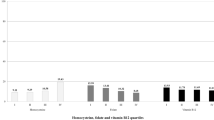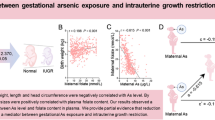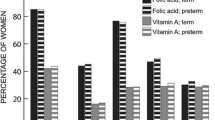Abstract
Objectives
To determine whether a low serum folate level during the first trimester predicts subsequent late abortion, preterm birth, or fetal growth restriction (FGR).
Study design
A prospective cohort study involving 5,075 women whose serum folate levels were measured during the first trimester. The participants were informed of their serum folate levels.
Results
The pregnancy duration, birthweight, rate of late abortion/preterm birth, and the rate of FGR did not differ significantly among the four groups classified according to folate status. The mean serum folate levels did not differ among quartiles classified according to the gestational week at the time of delivery. Nineteen of the 20 women with folate deficiency gave birth at term to infants with a birthweight of 3.132 ± 321 g; only one infant had FGR.
Conclusion
Low serum folate levels during the first trimester were not associated with the risk of late abortion, preterm birth, or FGR.


Similar content being viewed by others
References
Tamura T, Picciano M (2006) Folate and human reproduction. Am J Clin Nutr 83:993–1016
Cziezel AE, Dudas I (1992) Prevention of first occurrence of neural tube defects by periconceptional vitamin supplementation. N Engl J Med 327:1832–1835
MRC Vitamin Study Research Group (1991) Prevention of neural tube defects: results of the Medical Research Council Vitamin Study. Lancet 338:131–137
McPartlin J, Halligan A, Scott JM, Darling M, Weir DG (1993) Accelerated folate breakdown in pregnancy. Lancet 341:148–149
Iyengar L, Apte SV (1972) Nutrient stores in human foetal livers. Br J Nutr 27:313–317
Scott J (1984) Catabolism of folates. In: Blakley RL, Bankovic SJ (eds) Folates and pterins: chemistry and biochemistry of folates, vol 1. John Wiley, New York, pp 307–327
Rolschau J, Date J, Kristoffersen K (1979) Folic acid supplement and intrauterine growth. Acta Obstet Gynecol Scand 58:343–346
Ek J, Magnus M (1981) Plasma and red blood cell folate during normal pregnancies. Acta Obstet Gynecol Scand 60:247–251
Homocysteine lowering trialists’ collaboration (1998) Lowering blood homocysteine with folic acid based supplements: meta-analysis of randomised trials. BMJ 316:894–898
Holmes VA, Wallace JMW, Alexander HD, Gilmore WS, Bradbury I, Ward M, Scott JM, McFaul P, McNulty H (2005) Homocysteine is lower in the third trimester of pregnancy in women with enhanced folate status from continued folic acid supplementation. Clin Chem 51:629–634
Nelen WL, Blom HJ, Steegers EA, den Heijer M, Eskes TK (2000) Hyperhomocysteinemia and recurrent early pregnancy loss: a meta-analysis. Fertil Steril 74:1196–1199
Goddijn-Wessel TA, Wouters MG, Van de molen EF, Spuijbroek MD, Steegers-Theunissen RP, Blom HJ et al (1996) Hyperhomocysteinemia: a risk factor for placental abruption or infarction. Eur J Obstet Gynecol Reprod Biol 66:23–29
Cotter AM, Molloy AM, Scott JM, Daly SF (2001) Elevated plasma homocysteine in early pregnancy: a risk factor for the development of severe preeclampsia. Am J Obstet Gynecol 185:781–785
Siega-Riz AM, Savitz DA, Zeisel SH, Thorp JM, Herring A (2004) Second trimester folate status and preterm birth. Am J Obstet Gynecol 191:1851–1857
Kishi R, Sasaki S, Yoshioka E, Yuasa M, Sata F, Saijyo Y, Kurahashi N, Tamaki J, Endo T, Sengoku K, Nonomura K, Minakami H (2010) Cohort profile: the Hokkaido Study on Environment and Children’s Health in Japan. Int J Epidemiol 40(3):611–618. doi:10.1093/ije/dyq071
Itabashi K, Fujimura M, Kusuda S, Tamura M, Hayashi M, Takahashi T, Goishi K et al (2010) New criteria for normal birthweight according to gestational age at birth in Japanese infants. Nihon Shonika Gakkai Zasshi 114:1271–1293 (in Japanese)
El-Khairy L, Vollset SE, Refsum H, Ueland PM (2003) Plasma total cysteine, pregnancy complications, and adverse pregnancy outcomes: Hordaland homocysteine study. Am J Clin Nutr 77:467–472
Vollset SE, Refsum H, Irgens LM, Emblem BM, Tverdal A, Gjessing HK, Monsen ALB, Ueland PM (2000) Plasma total homocysteine, pregnancy complications, and adverse pregnancy outcomes: the Hordaland homocysteine study. Am J Clin Nutr 71:962–968
Jacques PF, Selhub J, Bostom AG, Wilson PWF, Rosenberg IH (1999) The effect of folic acid fortification on plasma folate and total homocysteine concentrations. N Engl J Med 340:1449–1454
Murakami S, Matsubara N, Saitoh M, Miyakawa S, Shoji M, Kubo T (2001) The relation between plasma homocysteine concentration and methylenetetrahydrofolate reductase gene polymorphism in pregnant women. J Obstet Gynecol Res 27:349–352
Lwin H, Yokoyama T, Date C, Yoshiike N, Kokubo Y, Tanaka H (2002) Are the associations between life-style related factors and plasma total homocysteine concentration different according to polymorphism of 5,10-methylenetetrahydrofolate reductase gene (C677T MTHFER)? A cross-sectional study in a Japanese rural population. J Epidemiol 12:126–135
Mercer BM (1998) Management of preterm premature rupture of the membranes. Clin Obstet Gyneocl 41:870–882
Ferguson SE, Smith GN, Salenieks ME, Windrim R, Walker MC (2002) Preterm premature rupture of membranes: nutritional and socioeconomic factors. Obstet Gynecol 100:1250–1256
Kundtson EJ, Simith K, Mercer BM, Miodovnik M, Thurnau GR, Goldenberg RL, Meis PJ, Moawad AH, Vandorsten JP, Sorokin Y, Roberts JM, Das A (2004) Serum homocysteine levels after preterm premature rupture of membranes. Am J Obstet Gynecol 191:537–541
Baker H, Thind IS, Frank O, DeAngelis B, Caterini H, Louria DB (1977) Vitamin levels in low-birth-weight newborn infants and their mothers. Am J Obstet Gynecol 129:521–524
Tamura T, Goldenberg RL, Freeberg LE, Cliver SP, Cutter FR, Hoffman HJ (1992) Maternal serum folate and zinc concentrations and their relationships to pregnancy outcome. Am J Clin Nutr 56:365–370
Kupferminc MJ, Eldor A, Steinman N, Many A, Bar-Am A, Jaffa A, Fait G, Lessing JB (1999) Increased frequency of genetic thrombophilia in women with complications of pregnancy. N Engl J Med 340:9–13
Nurk E, Tell GS, Refsum H, Ueland PM, Vollset SE (2004) Association between maternal methylenetetrahydrofolate reductase plolymorphisms and adverse outcomes of pregnancy: the Hordaland homocysteine study. Am J Med 117:26–31
Steegers-Theunissen RP, Van Iersel CA, Peer PG, Nelen WL, Steegers EA (2004) Hyperhomocysteinemia, pregnancy complications, and the timing of investigation. Obstet Gynecol 104:336–343
Hog BB, Tamura T, Johnston KE, DuBard MB, Goldenberg RL (2000) Second trimester plasma homocysteine levels and pregnancy-induced hypertension, preeclampsia and intrauterine growth restriction. Am J Obstet Gynecol 183:805–809
Gebhardt GS, Sholtz CL, Hillermann R, Odendaal HJ (2001) Combined heterozygosity for methylenetetrahydrofolate reductase (MTHFR) mutations C677T and A1298C is associated with abruptio placentae but not with intrauterine growth restriction. Eur J Obstet Gynecol Reprod Biol 97:174–177
Infante-Rivard C, Rivard G-E, Yotov WV, Génin E, Guiguet M, Weinberg C, Gauthier R, Feoli-Fonseca JC (2002) Absence of association of thrombophilia polymorphisms with intrauterine growth restriction. N Engl J Med 347:19–25
Yila T, Sasaki S, Miyashita C, Braimoh T, Kashino I, Kobayashi S, Okada E, Baba T, Yoshioka E, Minakami H, Endo T, Sengoku K, Kishi R (2012) Effects of maternal 5,10-methylenetetrahydrofolate reductase C6777T or A1298C polymorphism and tobacco smoking on infant birthweight in a Japanese population. J Epidemiol (Epub ahead of print)
Yamada T, Cho K, Endo T, Hanatani K, Minakami H (2009) Pregnancy outcome in women with no antenatal care in Hokkaido, Japan. Nihon Shusanki-Shinseiji Igakukai Zasshi 45:1448–1455 (in Japanese)
Conflict of interest
We declare that we have no conflict of interest.
Author information
Authors and Affiliations
Corresponding author
Rights and permissions
About this article
Cite this article
Yamada, T., Morikawa, M., Yamada, T. et al. First-trimester serum folate levels and subsequent risk of abortion and preterm birth among Japanese women with singleton pregnancies. Arch Gynecol Obstet 287, 9–14 (2013). https://doi.org/10.1007/s00404-012-2501-5
Received:
Accepted:
Published:
Issue Date:
DOI: https://doi.org/10.1007/s00404-012-2501-5




